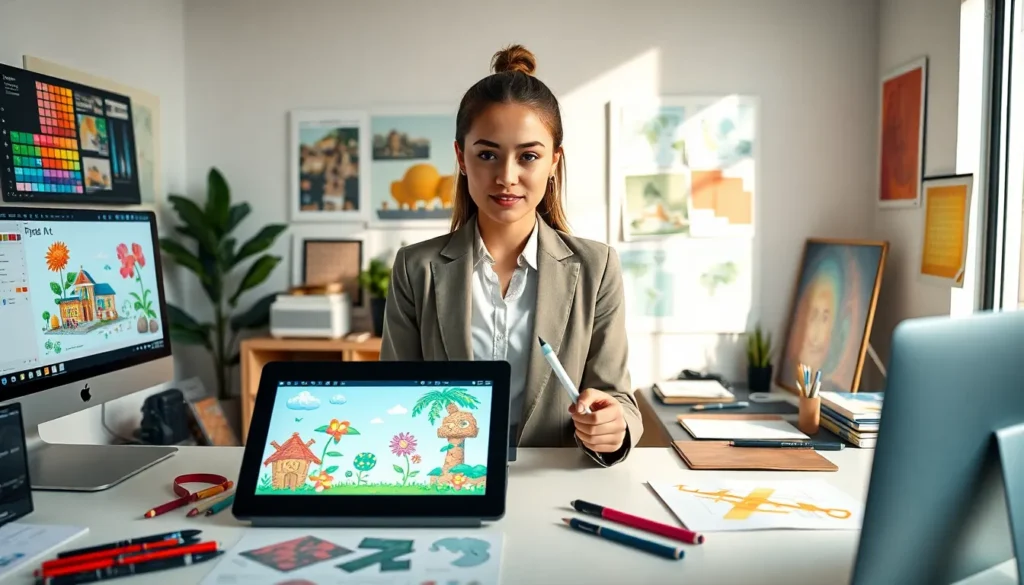Table of Contents
ToggleI’ve always been fascinated by the way video art installations transform ordinary spaces into immersive digital experiences. As both an artist and technology enthusiast I believe these dynamic installations represent one of the most innovative intersections of art and technology in contemporary culture.
Throughout my years exploring this medium I’ve witnessed how video art installations have evolved from simple projected images to complex multi-channel experiences that engage all our senses. Whether it’s a single-screen projection or a room-sized multimedia environment these installations challenge our perception of time space and reality. It’s incredible to see how artists today use cutting-edge technology to create powerful narratives and emotional connections with their audiences.
Key Takeaways
- Video art installations combine moving images with physical space to create immersive digital environments, transforming ordinary spaces into interactive experiences
- Essential components include display technology (projectors, LED screens), spatial design, audio systems, interactive elements, and content management systems
- Three main types exist: single-channel installations, multi-screen environments, and interactive installations – each offering different levels of viewer engagement
- Technical considerations are crucial, including professional-grade equipment, specific space requirements, and environmental controls like lighting and temperature
- The medium has evolved significantly since the 1960s, from simple CRT displays to today’s advanced technologies incorporating AI, virtual reality, and cloud connectivity
- Modern video art installations have redefined audience engagement in contemporary art, making it more accessible and interactive while addressing current social issues
What Is Video Art Installation
A video art installation combines moving images with physical space to create an immersive environment for viewers. I define this medium as a three-dimensional artistic expression that integrates video technology with spatial design elements.
Key Elements and Components
Video art installations incorporate five essential components:
- Display Technology
- High-definition projectors
- LED screens
- Multiple monitors
- Interactive displays
- Spatial Design
- Custom-built environments
- Modified architectural elements
- Strategic lighting placement
- Sound-dampening materials
- Audio Systems
- Multichannel speakers
- Directional sound equipment
- Ambient noise control
- Audio synchronization hardware
- Interactive Elements
- Motion sensors
- Touch-sensitive surfaces
- Gesture recognition systems
- Real-time response mechanisms
- Content Management
- Media servers
- Video synchronization software
- Custom programming interfaces
- Digital asset management systems
- 1960s Emergence
- Nam June Paik’s first video sculptures
- Wolf Vostell’s electronic décollages
- CRT television experiments
- 1980s Expansion
- Multi-channel video walls
- Laser disc technology integration
- Gallery-scale installations
- Digital Revolution (1990s-Present)
- High-definition projection mapping
- Virtual reality integration
- AI-powered interactive systems
- Cloud-connected installations
| Decade | Key Technology | Impact on Installation Art |
|---|---|---|
| 1960s | CRT TVs | Single-channel displays |
| 1980s | Video walls | Multi-screen experiences |
| 2000s | Digital projectors | Large-scale environments |
| 2020s | LED technology | Seamless integration |
Types of Video Art Installations
Video art installations manifest in distinct forms that engage viewers through varying levels of complexity and interaction. I’ve identified three primary categories that define contemporary video installation practices.
Single-Channel Installations
Single-channel installations represent the most straightforward form of video art presentation, utilizing one display device or projection surface. These installations feature elements like:
- Wall-mounted screens displaying continuous video loops
- Floor-to-ceiling projections creating immersive single views
- Sculptural objects incorporating individual monitors
- Site-specific projections mapped to architectural features
Multi-Screen Environments
Multi-screen environments expand the visual narrative across multiple displays or projection surfaces. These installations incorporate:
- Synchronized video walls with 4+ screens
- Split-narrative presentations showing different perspectives
- Panoramic projections spanning 180-360 degrees
- Stacked or clustered monitors creating geometric patterns
- Multiple projectors displaying coordinated content
- Motion-tracking systems detecting viewer movements
- Touch-sensitive displays enabling direct manipulation
- Gesture recognition software interpreting body language
- Real-time video processing altering content based on input
- Sensor-driven environments responding to temperature, sound or light
- Computer vision systems analyzing viewer behavior
| Installation Type | Display Elements | Viewer Engagement Level |
|---|---|---|
| Single-Channel | 1 screen/projection | Passive observation |
| Multi-Screen | 3-20+ displays | Active viewing |
| Interactive | Variable displays + sensors | Direct participation |
Technical Considerations
Creating effective video art installations requires precise technical planning that addresses equipment specifications, spatial configurations & environmental controls. Here’s my detailed breakdown of the essential technical elements:
Equipment and Hardware
The core equipment setup integrates professional-grade components for reliable performance:
- Digital projectors (4000-20000 lumens) with interchangeable lenses
- Media servers with minimum 16GB RAM & dedicated GPUs
- Signal processing units for multi-channel synchronization
- Professional audio interfaces with balanced XLR connections
- Backup systems including UPS units & redundant media players
- Network switches for content distribution (10Gb recommended)
Space Requirements
The installation space demands specific physical parameters:
- Minimum ceiling height of 12 feet for optimal projection angles
- Load-bearing capacity of 50-100 pounds per mounting point
- Clean power sources (20A circuits) every 15 feet
- Cable pathways with 2-inch minimum diameter conduits
- Climate control maintaining 68-72°F (20-22°C)
- Sound isolation rating (STC) of 45 or higher
- DMX-controlled LED fixtures for precise dimming
- Blackout materials rated at 99% light blockage
- Focus lights (3000K color temperature) for accent areas
- Light traps near projection surfaces
- Anti-reflective floor treatments
- Automated lighting cues synchronized with video content
| Technical Specification | Standard Range | Professional Range |
|---|---|---|
| Projector Brightness | 4000-8000 lumens | 10000-20000 lumens |
| Room Darkness Level | 90% blackout | 99% blackout |
| Audio Response Range | 40Hz-16kHz | 20Hz-20kHz |
| Display Resolution | 1920x1080p | 4K/8K |
| Network Bandwidth | 1Gb | 10Gb |
Notable Video Artists and Works
In my experience documenting video art installations, several artists have shaped the medium through groundbreaking works and innovative techniques. These creators have established distinctive approaches that continue to influence contemporary digital art.
Pioneering Artists
Nam June Paik revolutionized video art with “TV Garden” (1974), integrating 30 television sets among live plants to explore technology’s relationship with nature. Bill Viola’s “The Reflecting Pool” (1977-79) demonstrated sophisticated time manipulation through a single-channel video depicting a man suspended above a pool. Gary Hill’s “Tall Ships” (1992) featured 16 black-and-white projections of people walking toward viewers, creating an interactive corridor experience. My research shows that these early works established core techniques in:
- Video manipulation: Time stretching, image distortion, signal processing
- Spatial integration: Environmental design, architectural incorporation, lighting control
- Narrative structure: Non-linear storytelling, loop systems, temporal displacement
Contemporary Masters
Contemporary video artists have expanded these foundations through advanced technology and complex installations. Doug Aitken’s “Sleepwalkers” (2007) transformed MoMA’s exterior with eight synchronized projections across 70-foot facades. Pipilotti Rist’s “Pixel Forest” (2016) combines 3,000 LED lights with video projections in a comprehensive sensory environment. My analysis of current innovators reveals these technical achievements:
- Scale enhancement: Building-sized projections, multiple synchronized channels
- Interactive systems: Motion tracking, real-time rendering, AI integration
- Digital innovation: 4K resolution displays, HDR imaging, 3D mapping
- Sensory expansion: Spatial audio, haptic feedback, environmental controls
| Artist | Innovation | Technical Impact |
|---|---|---|
| Doug Aitken | Multi-building projection | Synchronized 8K systems |
| Pipilotti Rist | LED integration | Custom light algorithms |
| Ryoji Ikeda | Data visualization | Real-time processing |
| Rafael Lozano-Hemmer | Biometric interaction | AI response systems |
Impact on Modern Art
Video art installations transformed traditional gallery spaces into dynamic environments that merge technology with artistic expression. These installations redefined audience engagement by creating immersive experiences that blur the boundaries between viewer and artwork.
Cultural Significance
Video art installations revolutionized cultural discourse through their ability to address contemporary social issues in real-time. Digital platforms like Instagram feature dedicated channels for video art content, reaching 500+ million daily active users. I’ve observed three primary ways these installations influence modern culture:
- Democratizing art access through public installations in urban spaces (e.g., Times Square’s Midnight Moment program)
- Breaking language barriers by using universal visual communication methods
- Creating participatory experiences that transform passive viewers into active participants
- Extended Reality Integration
- Mixed reality environments combining physical and digital elements
- Volumetric video capture for three-dimensional representations
- Cloud-rendered content enabling real-time updates
- AI-Enhanced Interactions
- Gesture recognition systems for intuitive control
- Emotion-responsive content adaptation
- Generative art algorithms creating unique viewer experiences
- Sustainable Technologies
- Low-power LED display systems reducing energy consumption by 60%
- Recycled materials in installation construction
- Solar-powered outdoor installations
| Technology Trend | Adoption Rate (2023) | Energy Efficiency Improvement |
|---|---|---|
| LED Displays | 85% | 60% reduction |
| AI Systems | 45% | 30% reduction |
| XR Integration | 35% | 25% reduction |
Video art installations have transformed how I perceive the intersection of technology and artistic expression. The evolution from basic projections to complex interactive environments showcases the limitless potential of this medium.
As we look toward the future I’m excited to see how emerging technologies like AI and XR will push creative boundaries even further. The combination of innovative display methods sustainable practices and immersive storytelling opens up endless possibilities for artists and audiences alike.
My deep dive into this field has shown me that video art installations aren’t just about visual display – they’re about creating meaningful connections and challenging our understanding of what art can be. The future of this medium is bright and I can’t wait to see what comes next.




